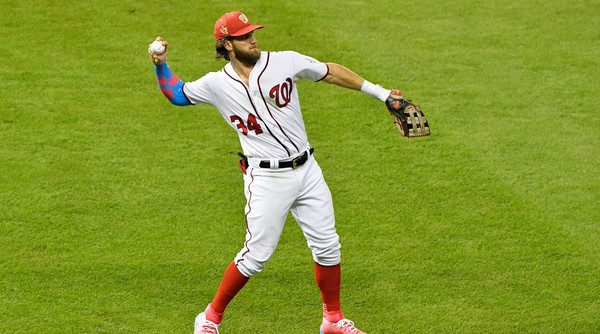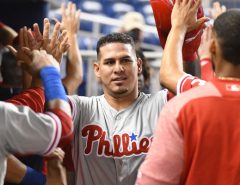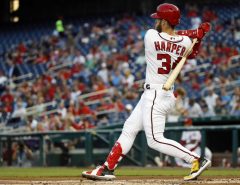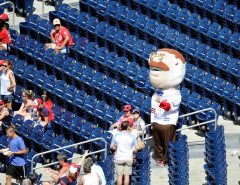The MLB All-Star Game and its corresponding festivities have hit the nation’s capital, a fitting sign that DC is as prominent as it has ever been in the baseball landscape. The Washington Nationals are now one of the most stable and successful franchises in the Major Leagues, backed by a city that has only shown increased support since the club started trending upwards in 2011.
So, due to the fact that the current Nationals team is hiccupping their way to the midseason break and I’m in the All-Star spirit, I decided to put together an all-time Nationals All-Star team, showcasing the franchise’s best players and best individual seasons. My totally random criteria is below.
The team consists of:
- 9 position players
- 5 starting pitchers
- 1 set-up man
- 1 closer
Montreal Expos need not apply. I know, I know, the Expos’ statistical history is technically also the Nats’ statistical history. But there’s no relationship between those two franchises beyond that. Even though I’m fascinated by the Expos’ tortured existence (and highly recommend you read this book about it) and even saw a game along with roughly 500 people at Stade Olympique many years ago, the national pastime disappeared from the nation’s capital for more than 30 years and the Washington Nationals changed that, not the Montreal Expos. I’ll only be pulling from Nats rosters.
My goal is to showcase the best individual season for a Nats player at each position, with exceptions made based on whatever the hell I want – sentiment, the player had a big moment in the regular or postseason, I just liked watching that particular player a lot during that specific season, etc. I’ll do my best to explain my decisions in the descriptions of each player.
No player can be featured more than once. However, there’s a certain player who could have been featured at two positions that ended up not making the cut at either and I have a feeling this may upset other die-hard Nats fans. But it’s my list, so deal with it.
Sorry, this skews heavily towards the 2012-17 Nats teams, but I’ll make sure to point out standouts from the 2005-11 editions in the Honorable Mentions when appropriate.
Okay, let’s have some fun. All stats are courtesy of Baseball-Reference.com.
Starting Lineup
C – 2016 Wilson Ramos (3.2 WAR, .307/.354/.496, 121 OPS+, All-Star)
This one is a little bittersweet to write. Wilson Ramos’ Nats career was filled with injuries, but even though he was healthy in 2015, he struggled throughout the year, ending up with an ugly .616 OPS. However, doctors discovered that Ramos had serious vision problems before the 2016 season, and after corresponding surgery, the catcher went on to have an outstanding year. Sadly, Ramos’ season ended with his second major knee injury, and the Nats missed his presence dearly in the NLDS against the Dodgers. They then let him hit free agency the following offseason, which is the primary reason the catcher position currently looks awful for the club (although they’re reportedly interested in bringing The Buffalo back to DC).
1B – 2012 Adam LaRoche (4.2 WAR, .271/.343/.510, 127 OPS+, Gold Glove, Silver Slugger, 6th in MVP voting)
The Nats have had some outstanding performances at first base over the years, as evidenced by the extensive Honorable Mentions list below. All those guys had better individual hitting seasons at first base than LaRoche’s 2012, but this one gets the nod for the lefty’s uncanny knack for picking it at first, his status as a prominent leader both on and off the field, the fact he led the first dominant Nats team in homers and RBIs and his huge solo homer in Game 4 of the NLDS against the Cardinals (Werth’s walk-off only ties the game without LaRoche’s shot). When I think of first basemen for the Nationals, I still think of Adam LaRoche.
Honorable Mention(s): 2006 Nick Johnson, 2009-10 Adam Dunn, 2011 Michael Morse, 2017 Ryan Zimmerman
Nick Johnson was a freaking monster in 2006, as he rocked a .948 OPS, which translated to a 149 OPS+. Johnson also walked 110 times with just 99 strikeouts, scored 100 runs, recorded 46 doubles and even stole 10 bases. Injuries unfortunately ravaged his career after that dominant season. Adam Dunn mostly played outfield for the 2009 Nats (which is hilarious), but did fit in 66 starts at first before playing 153 games there in 2010. The OPS+ for Dunn in those seasons: 144 and 138.
I had to get Mikey Morse in here somewhere – huge hat tip to his unforgettable warm-up at the plate, his blistering 147 OPS+ in 2011 and him saving Bryce’s career in that scuffle with the Giants last year. Ryan Zimmerman’s resurgent 2017 is mentioned because it was great to see Zim bounce back with 36 homers and 108 RBIs after three injury-plagued years.
2B – 2016 Daniel Murphy (4.5 WAR, .347/.390/.595, 155 OPS+, All-Star, Silver Slugger, 2nd in MVP voting)
I loved Danny Espinosa’s glove and occasional mammoth home runs when he played at second base, but Daniel Murphy’s 2016 was an absolute thing of beauty. Murph came over from the rival Mets after a record-setting, home run-hitting postseason and only continued the party in the District. I’m willing to bet that this stands as the best season of the slugger’s career when all is said and done.
SS – 2012 Ian Desmond (3.4 WAR, .292/.335/.511, 125 OPS+, All-Star, Silver Slugger)
Although Dezzy accumulated higher WAR totals in 2013 and ’14 because of better defensive ratings, the 2012 version offered a surprising, power-filled breakout that elevated the Nats lineup to one of the league’s best. Desmond had been the everyday shortstop in 2010 and ’11, showcasing speed while putting up pedestrian power numbers. In 2012, it all came together, as the free swinger put up the first of three consecutive 20-20 seasons while making his first All-Star team and winning the first of three straight Silver Slugger awards.
3B – 2017 Anthony Rendon (6.0 WAR, .301/.403/.533, 140 OPS+, 6th in MVP voting)
Yes, I know. Ryan Zimmerman is one of the most important players in Washington Nationals history and leaving him off of any franchise All-Star team is close to sacrilege. Zim’s 2009 is even statistically better, in some ways, than Rendon’s 2017. But Rendon’s calm and cool approach, silly skills at third base and status as quite possibly the most underrated player in baseball has me inch him just ahead of Ryan here. Rendon also had an MVP-type 2014 and is putting up impressive numbers in 2018. If Tony Two Bags signs a long-term extension to stay in DC beyond 2019, he’ll probably end up in the same Ring of Honor as Zimmerman.
Honorable mention: Ryan Zimmerman. Any pre-shoulder injury version of Ryan Zimmerman.
LF – 2015 Bryce Harper (10.0 WAR, .330/.460/.649, 198 OPS+, NL MVP, All-Star, Silver Slugger)
Okay, I broke the rules a little bit here. Harper’s 2015, which stands as not only the best individual season any Nats player has had but also one of the best seasons ANY hitter has had in the last 40 years or so, saw him spend most of his time in right field. I’m moving Harper to left here so that I can include 2013 Jayson Werth somewhere, because there is no way J-Dub is getting left off this completely ridiculous team.
Anyways, take a gander at those stats up above. Harper was a damn supernova in 2015, with many believing he had finally reached his full potential, and MVP trophies would start falling from the sky. Since then, injuries and underperformance have prevented Harper from having another season like it – and maybe he never will.
Honorable Mention: 2006 Alfonso Soriano
A 40-40 season has to at least be MENTIONED. 46 home runs, 41 stolen bases and 41 doubles? Only Harper’s mammoth 2015 and my weird obsession with Jayson Werth would cause 2006 Soriano to be bumped out of the lineup entirely. Sorry, Alfonso.
CF – 2014 Denard Span (3.8 WAR, .302/.355/.416, 113 OPS+, 1st in NL in hits, 31 stolen bases)
Every time I think of Denard Span, I think of Sade’s “Smooth Operator” playing in Nats Park after the speedster made a nice catch in center field. Span was a joy to watch in his three years in DC, so screw the defensive ratings that treated him poorly. He tracked down balls beautifully, was a blur on the base paths and it seemed like the dude never struck out (yep, only 65 total in 2014). Span and Rendon made a great 1-2 punch at the top of the lineup for the 2014 Nats (let’s not talk about Span’s 2-for-19 NLDS against the Giants).
RF – 2013 Jayson Werth (4.7 WAR, .318/.398/.532, 153 OPS+, incredible beard, at one point said he was ready to “eat face”)
J-Dub is my favorite player in Nationals history so you’re damn right I’m going to fit some version of him on this team. So, Werth’s best season as a Nat gets included here (his 2014 is a close second). The bearded outfielder only played in 129 games but did plenty of damage when he was on the field, totaling 25 home runs and 24 doubles while displaying his typical baserunning efficiency (10-for-11 stealing bases). Okay, the defense wasn’t great, but the man who altered the course of the franchise is manning right field for this hypothetical fantasy team and I will fight you over it.
Pitching Rotation
SP1 – 2015 Max Scherzer (7.3 WAR, 276 strikeouts, 2.79 ERA, 2.77 FIP in 228.2 IP, 2 No-hitters)
Weird choice, because Max won the Cy Young in 2016 and ’17 while leading the league in strikeouts both years. Hell, Max’s 2018 could easily end up outdoing his 2015 on a statistical basis. But 2015 Max provided us with two no-hitters (one of which I attended, so bonus points for sentimentality there) and a 16-strikeout, one-walk, one-bloop-hitter against Milwaukee. I’m throwing this Max believing that the potential for a soul-crushing, complete-game performance is just a smidge higher for him than the ’16, ’17 or ’18 versions.
SP2 – 2017 Stephen Strasburg (6.2 WAR, 204 strikeouts, 2.52 ERA, NL-leading 2.72 FIP in 175.1 IP, All-Star, 3rd in Cy Young voting)
We finally got to see peak Strasburg in 2017. Although the flamethrower missed a few starts (he totaled 28 on the year), he blew away his previous high in WAR, accomplished the year before (3.5). Even with just over 175 innings on the ledger, Strasburg still finished 3rd in Cy Young voting. And of course, there’s his two sterling starts in the NLDS against the Cubs, one of which kept the season alive in dominant fashion. Strasburg’s total numbers in that series: 14 IP, 22 strikeouts, 3 walks and no earned runs on 6 hits allowed.
SP3 – 2012 Gio Gonzalez (5.0 WAR, 207 strikeouts, 2.89 ERA, NL-leading 2.82 FIP in 199.1 IP, NL-leading 21 wins, All-Star, 3rd in Cy Young voting)
The first truly dominant season by a Nats starting pitcher, the first 20-game winner in club history and the ace of the first truly dominant Nats team. At this point, the lefty could throw 95-mph heat by you, then have you looking silly with one of his loopy curveball. This version of Gio only gets bumped down to the third spot in the rotation because of the nightmarish postseason starts against the Cardinals.
SP4 – 2014 Jordan Zimmermann (4.9 WAR, 182 strikeouts, 2.66 ERA, 2.68 FIP in 199.2 IP, threw first no-hitter in franchise history, All-Star, 5th in Cy Young voting)
Zimmermann was an essential part of the Nats’ world-beating rotation from 2012-14, using pinpoint fastball command to put together three straight seasons of elite production, with the third being his most brilliant. He produced two of the greatest pitching performances in club history in back-to-back starts: his no-hitter on the last day of the season against the Marlins and his nearly complete game gem against the Giants in Game 2 of the NLDS, pitifully ruined by Drew Storen. Mike Rizzo chose signing Max Scherzer over extending Zimmermann after 2014, a move that looks brilliant in hindsight, as Zimmermann has struggled throughout his time in Detroit. But the quiet dude from tiny Auburndale, Wisconsin left an indelible mark on the Nats.
SP5 – 2016 Tanner Roark (5.6 WAR, 2.83 ERA, 3.79 FIP in 210 IP)
Either 2014 or 2016 Roark was going in this spot, with the 2016 version winning out for the higher WAR and inning totals. Tanner is one of the Nats’ greatest success stories, a 26th round draft pick of another organization who came out of nowhere to be a valuable contributor on three division-winning teams. After Roark’s stunning 2014 was followed by an inconsistent 2015 in which his role was never clearly defined, he put together an outstanding 2016, accumulating more than 5 wins above replacement while eating well over 200 innings and increasing his strikeout rate. Regardless of how the rest of Roark’s Nats tenure plays out (and this year isn’t going so well), the fan base will always remember his workmanlike production, his grittiness in pressure situations and his incredible dad bod-long beard combo.
Honorable mention: 2014 Doug Fister
You may be surprised to learn that Doug Fister is still hanging in there, now pitching for the Texas Rangers. The journeyman put together some fantastic seasons in his prime, none more impactful than his 4.4 WAR-2014 with the Nats, which included 7 shutout innings against the Giants in Game 3 of the NLDS. Fister worked quickly and effectively, using a wondrous mix of finesse pitches to fool hitters into weak contact. He only spent two seasons in Washington, but his status as a fan favorite made it feel like a lot longer.
Bullpen
Set-Up Man: 2011 Tyler Clippard (3.4 WAR, 104 strikeouts, 26 walks, 1.83 ERA in 88.1 IP, All-Star)
There’s no way anyone but the glasses-rocking, knees-and-elbows-everywhere Clippard was getting this spot. The goofy right-hander confused one batter after another with his Bugs Bunny changeup that he could follow up or precede with a blazing fastball. Clippard was great for the 2012 and ’14 division-winning Nats, but his crown jewel was 2011 – 3.4 WAR for a reliever is insane. That’s the Tyler we’ll use here.
Closer: 2018 Sean Doolittle (2.1 WAR, 22 saves, 49 strikeouts, 3 walks, 1.45 ERA, 1.95 FIP in 37.1 IP, All-Star)
My only inclusion of a player from this year’s team. Drew Storen is a great guy off the field and could absolutely dominate on the field with his overpowering fastball and slider. But Game 5 against the Cardinals, Game 2 against the Giants and the punched-the-locker-and-broke-his-hand meltdown against the Mets in 2015 are just too damn prominent in my Nats memories. Closer has actually been a consistent issue over the years, but the Nats look to have found the solution in Dr. Doolittle. Hopefully his puppy-induced toe injury heals quickly.





Leave a Reply